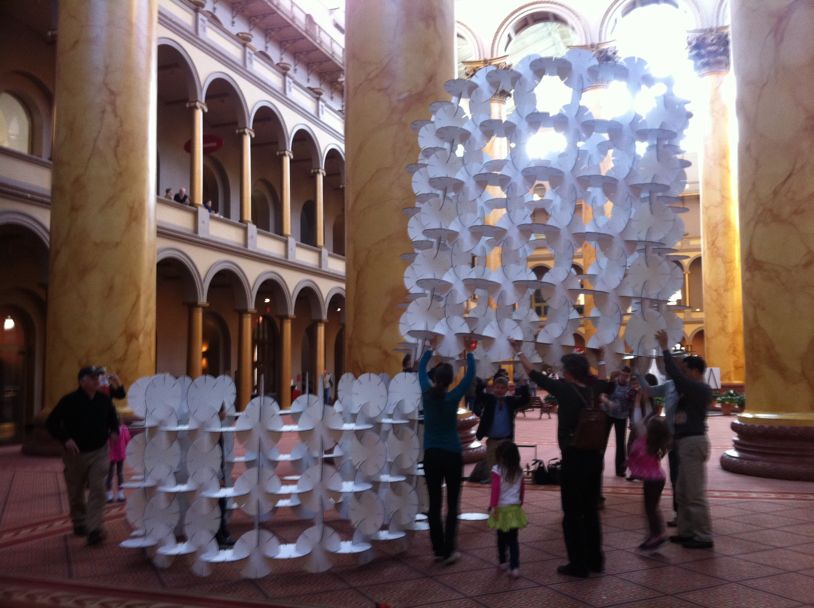
I particularly relish giving people, especially youth, ridiculously hard challenges that directly engage them in finding and solving some of the most pressing design problems in their everyday lives. Whether they are redesigning and rebuilding their own physically and emotionally decrepit K-12 schools; making high and low tech sensors to gather the environmental data, and stories that substantiates the redesign of their neighborhood; or designing a custom apron to help protect a local baker’s forearms from burning during her uniquely challenging baking process…………..empowering young adults to tackle and solve such weighty issues is both transformative, and can result in incredible innovation. And this is what I do through Public Workshop, working to create uniquely engaging opportunities for youth and their communities to shape the design of their cities.
But let’s forget complexity for a moment and hold off on saving the world until tomorrow.
My first building workshop for my Fellowship at the National Building Museum, was a wonderful reminder of the incredible power of simply getting a group of people together to build something impossibly ginormous.
Sure, there were some pretty fantastic creations and ideas explored during the first exercises and free-build portion of my workshop on Sunday, but when I asked the thirty odd visitors age 4-72 whether they wanted to build something impossibly tall, the room became electric and everyone’s eyes opened more than a little bit wider than they had been just a moment before.
Unlike every single other exercise this week, this one was a closed system- i.e. I had a really good idea in advance of how I wanted the final structure to look and feel. Size and scale represented the only opportunities for design input by participants. Much to surprise, this did not inhibit collaboration at all. Why? I chose to do a closed system because I wanted to get a baseline understanding of people’s pattern recognition skills with my disks. Pattern recognition is one determinant in how effectively people are able to participate in a design/learning process and how we design their engagement, and learning. In this case, despite having a relatively simple pattern, we ALL struggled mightily not to make mistakes. One theory is that because the disks are white, they tend to visually merge together making following even simple patterns a bit challenging. Another possibility is that the experience of assembly was still largely intellectual and not yet kinesthetic enough to make following the pattern an automatic action. Regardless, it was a blessing in disguise, forcing total strangers (age 4-72) to interact, negotiate and collaborate.
‘I had no idea that I would be problem solving and having to work, and collaborate with complete strangers to build amazing things today.’ ~a participant.
But the real joy came in the assembly of the rings into a silo. The collaboration and meticulous communication that had to occur when lifting and placing the rings on top of one another was great but even more so was the wide eyed joy experienced when participants were able to step back from a ‘lift’ to see the incredible fruits of their labor. And the aforementioned participant’s quote was not an anomaly- numerous people came up to me afterwards suggesting, without prompting, the role that the experience did and could play in building community, and dialogue.
Exactly.
Sure, I can’t wait to do completely open ended design challenges and learning experiments with Museum visitors in the coming days to test the limits of accelerating collaboration, learning and design innovation through ‘making’. However, the silo exercise was such a great reminder of the merits of a simple (temporary) barn raising in facilitating fantastic things in a larger participatory design or learning process.
-Alex Gilliam
The Stats for ‘Making As A Tool For Dialogue Workshop #1?
Participants- 26 total on the silo
Ages- 3-72
Number of Disks- 400
Participant Input- size and scale but otherwise ‘closed’
Time to Build- 75 minutes
Time to Deconstruct- 20 minutes with 6 people








C
14 years ago
Congratulations to an installation at the National Building Museum. It is amazing to see an architect and children sharing a pleasure of making collaborative design without rigid boundaries, rules, or regulation. The base unit and the idea are simple, yet can be highly articulated in form and process.
Good luck and I definitely look forward to seeing more great projects on this blog.
Harris Lokmanhakim
14 years ago
Thanks Alex, That was a fun excercise…I am glad Rebecca, Zak, Kathleen, Franco, Vito and Frankie and 1 came upon your wonderful workshop. Keep it up…
Harris L
Harris.Lokmanhakim@perkinswill.com